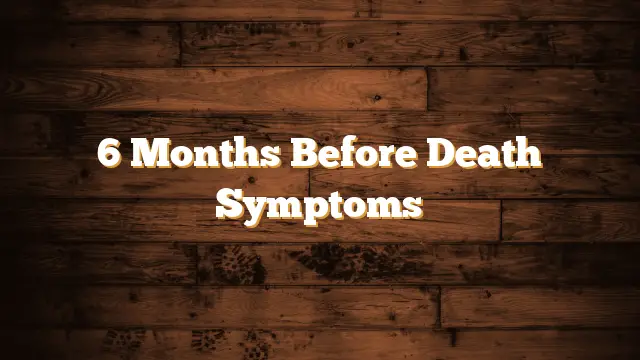Table of Contents
6 Months Before Death Symptoms
When it comes to identifying signs of imminent death, there are some obvious indicators you can spot. These include physical changes, hallucinations, and changes in behavior. If you notice any of these symptoms, it is likely that your loved one is on the road to death. If you’re concerned, you can seek medical assistance.
Symptoms of impending death
There are certain symptoms that can indicate a person’s imminent death. Some of these signs are normal, including pain, nausea, and breathlessness. Fortunately, these symptoms can usually be managed with medication. However, if you feel that you are experiencing them now, you should consult a doctor or nurse immediately.
A dying person may start to sleep more often and for longer periods of time. They may also refuse food or drink, including ice. This is important as trying to force food into their mouth can make them more uncomfortable. In such a case, a cool, moist cloth may help to relieve the discomfort.
Patients nearing death may appear confused and withdrawn. They may be unable to speak or see, and may spend more time in bed than awake. However, they are usually still able to hear, and family members should continue to talk to them. Physical changes are also common, and the patient may become weak, pale, and blotchy. Caregivers should also make sure the patient is comfortable. They can use a blanket to keep them warm, but not heating pads, as these can burn the skin.
Hallucinations
Hallucinations are a common symptom of the deteriorating brain, which can be frightening. These hallucinations often involve a person seeing or hearing things that aren’t really there. They may also talk to dead or unseen people and be confused about their surroundings. The person may also become restless and try to move around. This is distressing for the patient and their family. Fortunately, medical professionals can intervene at this point and treat the underlying cause of the hallucinations.
Many people have these hallucinations during their final days. Although they can be frightening, they can also be comforting to those who are suffering. In some cases, a person may see or hear long-gone family members, or see distorted visions. If this happens, it’s important to be prepared to explain this experience to your loved one.
Changes in behavior
During the final months of life, many people experience changes in their behavior that are indicative of impending death. For example, they may have difficulty getting up from their bed. They may also have trouble turning over. These changes may be signs that your loved one is nearing the end of their life.
While you’re around, try to stay as calm and compassionate as possible. You’ll likely want to avoid any unnecessary stress or discomfort for the dying person. While they may be unable to speak, they may be confused, speaking to people outside the room, or attempting to communicate with other people. They may even be scared or afraid of harm – even when it isn’t happening. It’s important to remain calm and encourage them.
Signs of reduced circulation
There are several symptoms that indicate a person may be nearing death, and one of the first is reduced circulation. The dying person’s heart rate and blood pressure will decrease, and the skin will become mottled and cool to the touch. The dying person’s lips and nail beds may also look bluish or pale. They may also become confused or incoherent.
The patient’s hands, feet, arms, and nose will become cool. The patient’s skin may look blotchy, blue, or even darker. The underside of the body will also appear darker. The face and ears may be paler and bluish gray.

